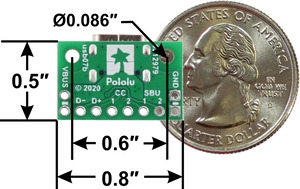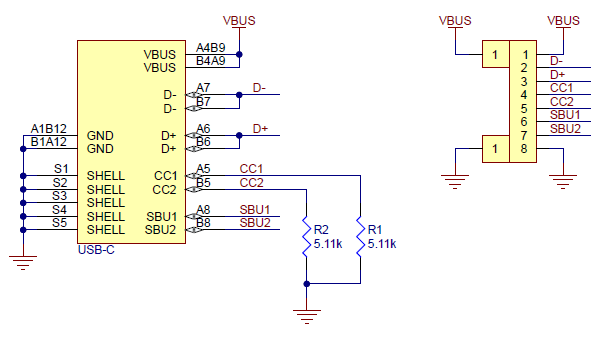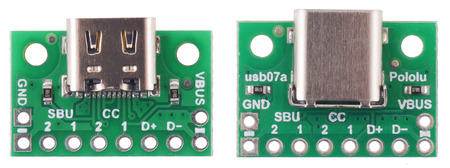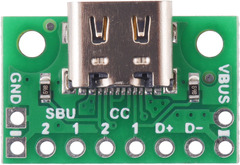
USB 2.0 Type-C Connector Breakout Board (usb07b)
Tutti i prezzi sono IVA inclusa
This simple board breaks out the power, USB 2.0 data, configuration, and sideband pins of a USB Type-C connector to a 0.1″ spacing that is compatible with standard perfboards, solderless breadboards, and 0.1″ connectors. On-board CC pull-down resistors make it easy to use the receptacle in a power-sinking application.
Overview
 |
USB 2.0 Type-C Connector Breakout Board (usb07b), bottom view with dimensions. |
|---|
The USB Type-C connector is intended to supersede a wide range of existing USB connectors. It is reversible and can serve in both USB host and USB device roles, allowing either end of a cable to be plugged into a receptacle with either side up, and it can support negotiation of increased power (up to 20 V and 5 A) and alternate uses of the USB interface wires.
The USB-C connector’s 16 tightly-spaced pins make it difficult to use in a hobby project or prototype design. This breakout board helps by providing access to the connector’s pins for power (VBUS and GND), USB 2.0 differential data (D+ and D−), Configuration Channel (CC), and Sideband Use (SBU). Each of these pins is broken out into a 1×8 row of 0.1″-spaced pins on the board, along with duplicate VBUS and GND pins for high-current applications. The included 1×10 straight male header can be soldered to these pins to allow the board to be used with standard perfboards, solderless breadboards, and 0.1″ connectors.
This board does not provide access to the USB 3.1 SuperSpeed differential pairs (TX and RX signals), so it only supports USB 2.0 Low-Speed, Full-Speed, and High-Speed communication.
This tiny unit measures only 0.8″ × 0.5″ (0.8″ × 0.55″ including its USB Type-C connector) and has two 0.086″ diameter mounting holes for #2 or M2 screws.
|
|
Using the breakout
Configuration and auxiliary pins
A Type-C receptacle can either provide power as a “Source” or consume power as a “Sink”; this usually corresponds to whether the port is a USB host (Downstream Facing Port, or DFP) or USB device (Upstream Facing Port, or UFP). The Configuration Channel, or CC, pins are used to determine the role of a port when it is connected.
This carrier board pulls the CC1 and CC2 pins to GND through 5.11 kΩ termination resistors, making the port a Sink and a UFP by default and allowing it to be a straightforward replacement for a Type-B, Mini-B, or Micro-B port on a USB device. If you want the port to serve as a Source instead, or if you want to perform more advanced configuration like USB Power Delivery negotiation, you can disconnect or remove the on-board resistors and make your own connections to the CC pins exposed by the board.
The Sideband Use, or SBU, pins are not used by the USB protocol. Instead, they are available for use after the USB interface has been configured to operate in an Alternate Mode, which allows it to be repurposed for other protocols and applications. This configuration is done through communication on the CC line between the host and device using the USB Power Delivery protocol.
See the USB Type-C Specification for a description of the USB-C configuration process and other technical details.
We manufacture these boards in-house at our Las Vegas facility, which gives us the flexibility to customize the CC termination resistors. If you are interested in customization, please contact us.
Schematic diagram
 |
This diagram is also available as a downloadable PDF: USB 2.0 Type-C Connector Breakout Board (usb07b) schematic (83k pdf)
Other USB breakouts
We have an alternative USB 2.0 Type-C Connector Breakout Board (usb07a) that uses a different style of connector and is slightly bigger, but is otherwise functionally identical to this board (usb07b).
 |
Comparison of USB 2.0 Type-C connector breakout boards: usb07b on left, usb07a on right. |
|---|
We also carry USB Mini-B and USB Micro-B connector breakout boards, and we have two power muxes that double as USB Micro-B breakout boards: the FPF1320 carrier and the TPS2113A carrier. These latter two power multiplexers make it easy to have a device that can be powered from both USB and an external supply.










